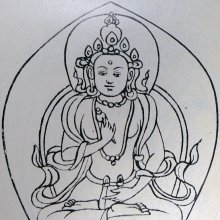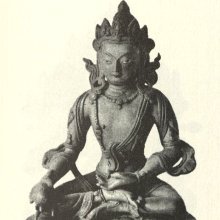Gandhahastin, Gandhahasti, Gandhahastī, Gandha-hastin, Gandha-hasti: 13 definitions
Introduction:
Gandhahastin means something in Buddhism, Pali, Hinduism, Sanskrit. If you want to know the exact meaning, history, etymology or English translation of this term then check out the descriptions on this page. Add your comment or reference to a book if you want to contribute to this summary article.
Images (photo gallery)
In Buddhism
Tibetan Buddhism (Vajrayana or tantric Buddhism)
Source: Wisdom Library: MañjuśrīnāmasaṃgītiGandhahastin (गन्धहस्तिन्) is one of the sixteen bodhisattvas appearing in the Vajradhātu-mahāmaṇḍala, according to the Nāmamantrārthāvalokinī v5.38-41. The Nāmamantrārthāvalokinī (literally, ‘an explanation of the nāma-mantras’) is a commentary (ṭīkā) on the 8th century Mañjuśrīnāmasaṃgīti.
Gandhahastin is a name of Mañjuśrī (the embodiement of non-dual knowledge) and, together with other names, forms the core essence of the Mañjuśrīnāmasaṃgīti. The Nāmamantrārthāvalokinī provides the practitioner a sādhana (‘meditative practice’) to turn these names into mantras. These mantras are chanted for the benefit of all beings, and then placed and contemplated in the Vajradhātu-mahāmaṇḍala, which is an extended version of the Vajradhātu-maṇḍala.
Source: Wisdom Library: Tibetan BuddhismGandhahastin (गन्धहस्तिन्) is the name of a Bodhisattva mentioned as attending the teachings in the 6th century Mañjuśrīmūlakalpa: one of the largest Kriyā Tantras devoted to Mañjuśrī (the Bodhisattva of wisdom) representing an encyclopedia of knowledge primarily concerned with ritualistic elements in Buddhism. The teachings in this text originate from Mañjuśrī and were taught to and by Buddha Śākyamuni in the presence of a large audience (including Gandhahastin).
Source: archive.org: The Indian Buddhist IconographyGandhahasti (गन्धहस्ति) is the name of a Bodhisattva commonly depicted in Buddhist Iconography, and mentioned in the 11th-century Niṣpannayogāvalī of Mahāpaṇḍita Abhayākara.—his color is green or whitish-green; his symbol is the elephant’s trunk or conch.—Gandhahasti is represented only once in the Chinese collection. His images are very rare.
Gandhahasti is described in the Niṣpannayogāvalī as follows:—
Source: Brill: Śaivism and the Tantric Traditions (tantric Buddhism)(1: Mañjuvajra-maṇḍala):—“Gandhahasti is green in colour and holds in the left hand the trunk of an elephant on a lotus. The right hand exhibits the Varada-mudrā”. (2: Durgatipariśodhana-maṇḍala):—“Gandhahasti is whitish-green in colour. He holds in his right hand the conch containing sandal-paste. The clenched left is placed on the hip”.
Gandhahastin (गन्धहस्तिन्) refers to one of the sixteen Bhadrakalpa Bodhisattvas, according to the Niṣpannayogāvalī 44ff and Abhayākaragupta’s Durgatipariśodhana-maṇḍala (Cf. Niṣpannayogāvalī 66ff.).—A set of sixteen Bodhisattvas often supplements the deities of the Tattvasaṃgraha in later Vajradhātu-maṇḍala descriptions. These are generally the sixteen Bodhisattvas of the present aeon (bhadrakalpa) [e.g., Gandhahastin], as described for example in Abhayākaragupta’s Niṣpannayogāvalī Vajradhātu-maṇḍala.—Cf. also Nāmamantrārthāvalokinī and Abhayākaragupta’s forty-three deity Mañjuvajra-maṇḍala (Tricatvāriṃśadātmakamañjuvajra-maṇḍala: see Niṣpannayogāvalī 50)

Tibetan Buddhism includes schools such as Nyingma, Kadampa, Kagyu and Gelug. Their primary canon of literature is divided in two broad categories: The Kangyur, which consists of Buddha’s words, and the Tengyur, which includes commentaries from various sources. Esotericism and tantra techniques (vajrayāna) are collected indepently.
Mahayana (major branch of Buddhism)
Source: Wisdom Library: Maha Prajnaparamita SastraGandhahastin (गन्धहस्तिन्) refers to “perfumed white elephants”, according to Mahāprajñāpāramitāśāstra (chapter 41).—Accordingly, “[Digression on a case brought against the Buddha; B. The defense].—[6. Use of a Stone Bowl].—‘The Buddha forbade the Bhikṣus to use eight kinds of bowls (pātra)’.—[...] As for the stone (śaila) bowl, it is thick (audārika) or thin (sūkṣma). Thin, it does not retain bad grease and that is why the Buddha used it himself, but he does not allow the Bhikṣus to keep them because of their weight. A swallow of milk by the Buddha surpasses in power that of a myriad of perfumed white elephants (gandhahastin); this is why [the stone bowl] does not seem heavy for him, but out of compassion (karuṇā) for the Bhikṣus, he does not allow them to keep them. [...]”.
Source: academia.edu: A Study and Translation of the GaganagañjaparipṛcchāGandhahastin (गन्धहस्तिन्) is the name of a Bodhisattva, according to the Gaganagañjaparipṛcchā: the eighth chapter of the Mahāsaṃnipāta (a collection of Mahāyāna Buddhist Sūtras).—Accordingly, “Then the Bodhisattva Gaganagañja said this to the congregation of Bodhisattvas: ‘Sons of good family, may all of you elucidate the gates into the dharma of transcending the path of the works of Māra’ [...] The Bodhisattva Gandhahastin said: ‘The weak can be harmed by the Māra; but the strong cannot be harmed by the māra. The weak is afraid of the three gates of liberation. Since the strong is not afraid of the three gates of liberation, namely, directly seeing, penetrating, and meditatively cultivating. One who is not afraid of them transcends the sphere of the Māra, and thus this is the gate into the light of the dharma called “Transcending the sphere of the Māra”’”.

Mahayana (महायान, mahāyāna) is a major branch of Buddhism focusing on the path of a Bodhisattva (spiritual aspirants/ enlightened beings). Extant literature is vast and primarely composed in the Sanskrit language. There are many sūtras of which some of the earliest are the various Prajñāpāramitā sūtras.
Languages of India and abroad
Sanskrit dictionary
Source: DDSA: The practical Sanskrit-English dictionaryGandhahastin (गन्धहस्तिन्).—m. 'the scent-elephant', an elephant of the best kind; यस्य गन्धं समाघ्राय न तिष्ठन्ति प्रतिद्विपाः । स वै गन्धगजो नाम नृपतेर्विजयावहः (yasya gandhaṃ samāghrāya na tiṣṭhanti pratidvipāḥ | sa vai gandhagajo nāma nṛpatervijayāvahaḥ) || Pālakāpyam; शमयति गजानन्यान्गन्धद्विपः कलभोऽपि सन् (śamayati gajānanyāngandhadvipaḥ kalabho'pi san) V.5. 18; R.6.7;17.7; गन्धेन जेतुः प्रमुखागतस्य गन्धद्विपस्येव मतङ्गजौघः (gandhena jetuḥ pramukhāgatasya gandhadvipasyeva mataṅgajaughaḥ) | Kirātārjunīya 17.17.
Gandhahastin is a Sanskrit compound consisting of the terms gandha and hastin (हस्तिन्). See also (synonyms): gandhebha, gandhagaja, gandhadvipa.
--- OR ---
Gandhahastin (गन्धहस्तिन्).—m. a scent-elephant; यस्य गन्धं समाघ्राय न तिष्ठन्ति प्रतिद्विपाः । तं गन्धहस्तिनं प्राहुर्नृपतोर्विजयावहम् (yasya gandhaṃ samāghrāya na tiṣṭhanti pratidvipāḥ | taṃ gandhahastinaṃ prāhurnṛpatorvijayāvaham) || Pālakāpyam.
Gandhahastin is a Sanskrit compound consisting of the terms gandha and hastin (हस्तिन्).
Source: Cologne Digital Sanskrit Dictionaries: Edgerton Buddhist Hybrid Sanskrit DictionaryGandhahastin (गन्धहस्तिन्).—name of a Bodhisattva: Mahāvyutpatti 704; Aṣṭasāhasrikā-prajñāpāramitā 474.2; Sukhāvatīvyūha 92.11; Samādhirājasūtra p. 36, line 1. The word occurs in Sanskrit and AMg. (°hatthī) in the sense of an elephant in the climax of must, i.e. in the fourth stage of must, de- scribed in Mātaṅgalīlā ix.15; this meaning is also found Mahāvyutpatti 8209, where °hasti-balam is contrasted with 8208 prākṛta- hasti-balam, strength of an ordinary elephant.
Source: Cologne Digital Sanskrit Dictionaries: Benfey Sanskrit-English DictionaryGandhahastin (गन्धहस्तिन्).—m. a kind of elephant (in rut?), [Rāmāyaṇa] 5, 73, 26.
Gandhahastin is a Sanskrit compound consisting of the terms gandha and hastin (हस्तिन्).
Source: Cologne Digital Sanskrit Dictionaries: Monier-Williams Sanskrit-English Dictionary1) Gandhahastin (गन्धहस्तिन्):—[=gandha-hastin] [from gandha] a m. = -gaja, [Rāmāyaṇa v f.]
2) [v.s. ...] Name of an antidote (said to be very efficacious), [Caraka]
3) [v.s. ...] of the author of a [commentator or commentary] on Ācārāṅga ([i, 1]), [Śīlāṅka]
4) [=gandha-hastin] [from gandha] b m. Name of a Tathāgata, [Sukhāvatī-vyūha ii]
[Sanskrit to German]
Sanskrit, also spelled संस्कृतम् (saṃskṛtam), is an ancient language of India commonly seen as the grandmother of the Indo-European language family (even English!). Closely allied with Prakrit and Pali, Sanskrit is more exhaustive in both grammar and terms and has the most extensive collection of literature in the world, greatly surpassing its sister-languages Greek and Latin.
Kannada-English dictionary
Source: Alar: Kannada-English corpusGaṃdhahasti (ಗಂಧಹಸ್ತಿ):—[noun] = ಗಂಧವಾರಣ [gamdhavarana].
Kannada is a Dravidian language (as opposed to the Indo-European language family) mainly spoken in the southwestern region of India.
See also (Relevant definitions)
Partial matches: Gandha, Hastin.
Ends with: Mahagandhahastin.
Full-text (+1): Gandhahastimahatarka, Mahagandhahastin, Gandhebha, Gandhadvipa, Gandhahasti-mada, Karika, Sadadana, Bodhisattva, Tantra, Gandhagaja, Durbala, Sukshma, Parasparapariharasthiti, Sahanavasthana, Balika, Vadhyaghataka, Virodha, Tapas, Mada, Varanga.
Relevant text
Search found 12 books and stories containing Gandhahastin, Gandhahasti, Gandhahastī, Gandha-hastin, Gandha-hasti, Gaṃdhahasti, Gandha-hastī, Gaṃdha-hasti, Gamdhahasti, Gamdha-hasti; (plurals include: Gandhahastins, Gandhahastis, Gandhahastīs, hastins, hastis, Gaṃdhahastis, hastīs, Gamdhahastis). You can also click to the full overview containing English textual excerpts. Below are direct links for the most relevant articles:
Atharvaveda and Charaka Samhita (by Laxmi Maji)
Viṣa (poison) according to Caraka < [Chapter 4 - Diseases and Remedial measures (described in Caraka-saṃhitā)]
The Indian Buddhist Iconography (by Benoytosh Bhattachacharyya)
Maha Prajnaparamita Sastra (by Gelongma Karma Migme Chödrön)
Bodhisattva quality 21: skilled in saving beings < [Chapter XI - The Ten Comparisons]
I. Recollection of the Buddha (3): Physical marks and superhuman power < [Part 2 - The Eight Recollections according to the Abhidharma]
Part 14 - The omniscient Buddha < [Chapter IV - Explanation of the Word Bhagavat]
Buddhist records of the Western world (Xuanzang) (by Samuel Beal)
Introduction (i): Preface to the “Ta-t’ang-si-yu-ki” by Chang Yueh
Chapter 2 - Country of Mo-kie-t’o (Magadha), part 2 < [Book VIII and IX]
Charaka Samhita (English translation) (by Shree Gulabkunverba Ayurvedic Society)
Chapter 23 - The therapeutics of Toxicosis (visha-cikitsa) < [Cikitsasthana (Cikitsa Sthana) — Section on Therapeutics]

